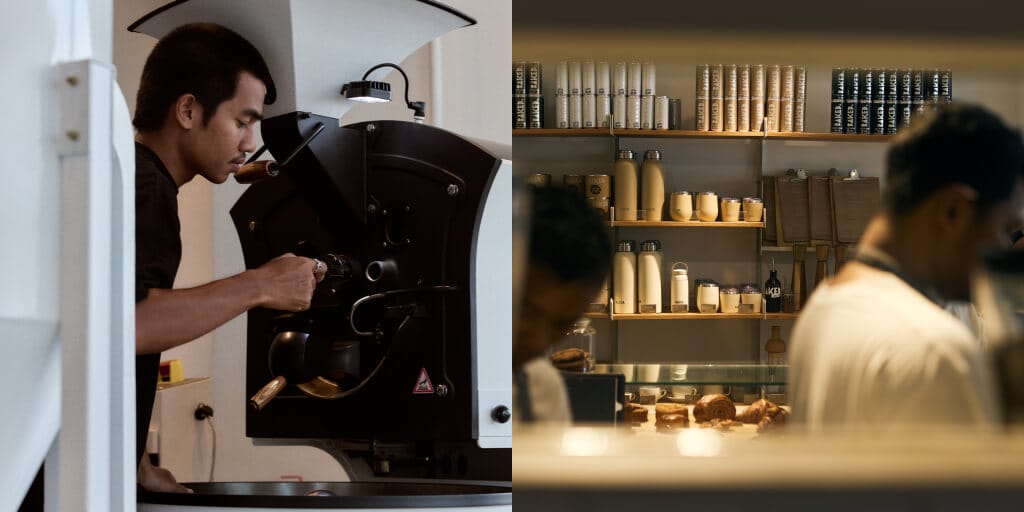With coffee prices at historic highs of over US $4/lb, roasters are being pushed to manage their already tight margins more effectively. It’s never been more important to balance quality and cost efficiency without compromising too much of either.
Different pricing strategies have long been used to capture and retain customers. By offering a range of coffee across various quality levels, roasters can diversify their consumer base and maintain solid relationships.
But at a time when roasters are all facing the same challenges, price can’t be the only differentiating factor. Difficult, volatile market conditions are pushing them to become more creative and innovative while still adopting a more pragmatic approach to their businesses.
I spoke to Scott Angelo, co-founder of Oceana Coffee, Dave Stanton, founder of Crankhouse Coffee Roasters, Mark Inman, North American Director of Sales at Covoya Coffee, and Darleen Scherer, founder of Black Sheep consultancy, to find out how roasters can compete on more than price and find ways to adapt and stay successful.
You may also like our article on how record arabica futures signal a new era for coffee.

How do roasters price their coffee?
Many coffee shops and roasters are facing an unprecedented year marked by record arabica futures, high interest rates, and rising business costs across the board. Managing already tight margins in an increasingly saturated market, it’s critical that they reevaluate their pricing strategies to stay competitive.
Prices – whether for a cup of coffee or a retail bag of beans – can be determined based on several models.
One of the most straightforward ways is to apply the cost plus pricing model. This is when a markup percentage or the desired profit margin is added to the total cost of production, resulting in the final product price. However, this model doesn’t take consumer demand or competitors’ pricing strategies into account.
Another option is the competitor-based pricing model, in which a roaster sets prices below (penetration pricing) or above (skim pricing) their competitors, positioning themselves as either the more cost-effective or premium option to attract customers.
This method is particularly effective for newer roasters and coffee shops, but it can lead to missed opportunities in the long run if prices don’t reflect the value of the products.
This is when value-based pricing comes in. Roasters and coffee shops set prices based on consumers’ perceived value of the goods. Although this approach requires extensive market and consumer research, it maximises profit margins by establishing the highest amount consumers are willing to pay without driving them to competitor brands.
Margins are being squeezed: Why pricing will become more competitive
Roasters often operate on tight margins for a number of reasons. The high costs associated with sourcing quality green coffee, volatile coffee prices, rising operational costs like energy and labour, and the need to invest in specialised equipment can add strain to business models.
Additionally, the inherently competitive nature of the specialty coffee market means smaller roasters can struggle to sell large volumes at premium prices.
Sustained high arabica and robusta futures apply more pressure onto roasters, squeezing slim margins even more. At the current rate, waiting for prices to drop or stabilise leaves roasters vulnerable, running the risk of low inventories and applying more pressure to secure supply.
“In 2015, we came very close to not existing, and at that point, we were well past being a hobby and had become a small business, but probably hadn’t realised it at the time,” says Scott Angelo of Oceana Coffee. “As a result, we quickly had to learn and build a business mindset; we looked at every aspect of the company and operated from a percentage-game point of view. Margins are everything, from takeaway cups and lids to how we buy and contract green coffee.”
Unable to absorb rising costs, many roasters now have to increase their retail prices and rethink sourcing strategies to stay competitive, aiming to retain their consumer base and potentially attract a more diverse audience.
Increasing retail prices is rarely an easy or comfortable decision for roasters and coffee shops. While shifting to more affordable, lower-quality coffee can be an effective way to avoid price hikes, roasters risk undesirable knock-on effects.
“A common trap roasters fall into is going down in quality, seeking lower prices to weather the market. But while you may be in tune with the market, your customer is not,” says Mark Inman, the North American Director of Sales at specialty green coffee trader Covoya Coffee. “What they experience is that the quality they have become accustomed to drops. Regular customers who drink your coffee daily will notice even slight changes.
“Roasters are far better off raising prices with a clear explanation as to why. They may want to discontinue limited-time offerings on higher-end coffees or tweak blends to find savings,” Mark adds. “For example, in this current market climate, some Kenyan coffees can be purchased considerably cheaper than Guatemalan coffees, helping improve blends while saving money.”

Roasters are pushed to find new ways to adapt
All signs point to a prolonged period of high arabica and robusta futures. The worsening climate crisis remains a key risk to coffee-growing regions, with rising temperatures and unpredictable rainfall threatening global supplies. At the same time, labour shortages in origin countries, the high costs of farming inputs, and global political instability exacerbate market conditions.
To manage this increasingly complex environment, roasters and coffee shops will need to raise their prices and find a middle ground that meets the needs of their business model and customers. Ultimately, this means pricing will become even more competitive, forcing roasters to find new ways to adapt – or risk losing out.
Some roasters are exploring direct trade relationships with producers to manage supply chains more closely and secure more stable prices.
“Focus on finding producers who consistently deliver coffees scoring in the 80 to 85-point range, which often provide excellent value while maintaining respectable quality standards,” says Darleen Scherer, the founder of Black Sheep coffee consultancy, who has over 20 years experience working in the industry.
Other roasters, meanwhile, are expanding their product lines to include blends that combine more affordable coffees with specialty-grade beans. This strategy aims to reduce costs without compromising on flavour profile and quality.
“Creating strategic blend programmes is another solution,” Darleen adds. “By thoughtfully combining a smaller percentage of premium coffees with well-chosen supporting coffees, roasters can maintain cup quality while better managing costs.”
Why maintaining quality is a key priority
Speciality coffee roasters have long differentiated themselves based on quality. Higher-scoring, exceptional lots are a clear indicator of quality to consumers, increasing the perceived value of the product and commanding higher prices.
But as customers become more price-conscious, their purchasing behaviour will inevitably shift. Many will seek out more affordable options but still expect similar levels of quality and flavour. This presents roasters with the unique challenge of balancing quality and price.
“Roasters need to be very careful when contracting too much coffee at these heightened prices and keeping stock levels down,” says Dave Stanton, the founder of Crankhouse Coffee Roasters in Exeter, UK. “There’s a temptation to buy lower-quality coffees to keep costs relatively stable and not increase prices too much, but they are dangerous waters; some customers are likely to recognise the quality drop-off.”
Coffee shops and roasters may have to become more selective in their offerings, leading to a more noticeable distinction between their premium single origins and economical blends.
“Balancing quality and costs is not about cutting corners to make a quick buck. It’s an easy trap to fall into buying “cheap” coffee, last year’s crop, lower grades, or even buying fillers and passing them off as specialty,” Scott says. “Find out what your customers want and balance it with what you can afford.”

How can roasters find new points of differentiation?
For roasters and coffee shops, 2025 will present challenges and opportunities. Competition will intensify, making it harder to stand out. Many businesses now face the same obstacles to growth and success, underscoring the need to remain creative, innovative, and agile.
Over the last few years, rebranding has emerged as an effective strategy for specialty coffee roasters. By modernising their brand identity and imagery, roasters can stay relevant to their customers, which could prove particularly pertinent as retail prices increase.
“Companies typically rebrand every seven to ten years to stay current, and coffee businesses often need to refresh even more frequently due to rapid market evolution,” Darleen says. “However, successful rebranding requires more than just updating visual elements. It’s often necessary to go back to the drawing board and uncover your brand’s value proposition and mission statement and redefine target audiences.”
As roasters shift their sourcing strategies, pivoting to more economical coffees and origins that attract new customers, rebranding could be a well-founded decision. However, retaining existing loyal customers still needs to be a priority.
“Successful rebrands emerge from this deeper strategic work and help companies communicate their differentiation in ways that resonate with new target audiences,” Darleen adds. “The investment can be particularly worthwhile when it helps capture new market segments or strengthen existing customer relationships through improved brand relevance and clarity of purpose.”
Offering more than coffee
Roasters and coffee shops face increasing economic pressures, which are recalibrating the industry’s landscape and forcing them to adapt. While the focus is often on managing margins to optimise operational and cost efficiency, establishing targeted strategies to engage with wholesale clients and customers in a more hands-on way can’t be overlooked.
“Run regular public cuppings to keep your local customer base engaged with your brand, or run training days for wholesale customers,” Dave says. “Communication is key to both wholesale and retail customers. Let everyone know where you stand, what you’ll be doing to manage your offerings, and that their opinions and feedback are welcome and encouraged.”
With both wholesale and retail clients becoming increasingly price-conscious, perceived value for money that matches quality expectations is at the forefront of their purchasing decisions. Roasters that can offer additional services are likely to retain existing customers and attract new ones.
“Service will always win in this industry,” Mark tells me. “Do you provide adequate information on the coffees you offer? Or offer barista training? Do you sell equipment or offer servicing? It’s these little things that set one roaster apart from another.”
Maintaining and showcasing brand authenticity can also offer stability during periods of economic volatility, reassuring clients and customers that roasters can adapt while remaining true to their values and ethos.
“Success in coffee now encompasses more than product quality – it includes developing experiential approaches that integrate supply chain transparency, sustainability initiatives, and thoughtful retail experiences,” Darleen says. “This means developing genuine connections with your audience through thoughtful social media engagement, personalised loyalty programmes, and targeted email communications that share not just products but the stories behind your company and coffee selections.
“Being responsive to customer feedback, transparent about challenges, and consistently sharing your journey – from origin relationships to roasting philosophy – creates emotional connections that transcend price considerations.”

Roasters use various pricing strategies to remain competitive. However, as business costs, coffee prices, and inflation rates rise, they are forced to find new ways to stand out – or risk falling behind.
Ultimately, to counteract price increases and offer stability during a volatile environment, both wholesale and retail customers will expect roasters to diversify their products and services, providing value for money when it’s needed the most.
Enjoyed this? Then read our article on why roasters need to be strategic with menu prices.
Photo credits: Covoya Coffee, Crankhouse Coffee Roasters
Perfect Daily Grind
Want to read more articles like this? Sign up for our newsletter!
Escape from it all while still enjoying the comforts of home. Discover Expedia's array of vacation rental options—from cozy city apartments to picturesque beachfront villas.
Source link



